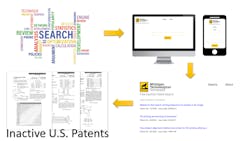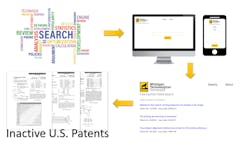Use the U.S. Patent System to Innovate (While Avoiding Willful Infringement)
Imagine you are designing a new, complicated machine and you hit a technical problem. You might start with a literature review to see what people have done before to solve a similar problem. It might be helpful to use the U.S. patent database, which holds millions of inventions—some of which may be directly relevant to the machine you are building. This, after all, was the original intent of the patent system.
Sadly, your boss has told you specifically not to look at the database, because if you look at the patent literature you could be liable for “willful infringement” and patent trolls could wreak havoc on your company. However, inactive patents are able to be used without worry of infringement. In the hope of fostering the acceleration of innovation, Michigan Technological University started a free inactive patent search to find public domain in intellectual property. Inactive patents are normally the result of the patent holder not paying a maintenance fees. This means they are not able to defend themselves against infringement. Another way of putting this is, inactive patents are in the public domain and free to use.
Background on the Broken Patent System
The founding fathers could never have predicted that the patent system would become such a mess. Patents were initially written into the U.S. Constitution to enhance innovation, yet now many argue that patenting actually slows technological progress overall (no matter if we are talking about software patents or nanotechnology patents). The original idea was patents would enable inventors to earn a return on investment for their efforts in creating new useful artifacts using a 20-year intellectual monopoly to keep competitors at bay. In exchange, the rest of the United States of America benefited from access to the “intellectual property” after 20 years.
Back in the day when serious men wore white wigs, a 20-year innovation cycle didn’t seem so bad. Since then, we all know the rate of innovation has been put on speed and accelerated substantially. Consider how sad 20-year-old computers are compared to the smartphone in your pocket. There is general consensus that the patent system is simply broken. The majority of scholars studying patents argue that researchers do not even bother to read them now. As a partial solution, my group has called for patents to be significantly weakened. For example, if the monopoly were shorter patents still relevant to today's technology could actually be used more often by innovators.
Many companies still benefit from patents—including the whole industry of “non-practicing entities” (NPEs, sometimes called “patent trolls”). NPEs are companies that attempt to enforce patent rights against accused infringers far beyond the patent's actual value or contribution to the prior art. Normally, NPEs do not actually manufacture products or supply services based upon the patents they attempt to enforce. This has caused such a problem that even the U.S. government has complained: “An analysis of recent research...suggests that a substantial amount of patent litigation in the United States, often with little substantive merit, often arises from certain types of NPEs.”
So even those working for traditional intellectual-property-loving corporations are told not to look at the patent literature when innovating, as it could weaken their legal arguments in anticipated lawsuits. This essentially handcuffs innovators to searching for 20-year-old (or older) patents if they even look at the patent database at all. To search for patents that have expired, you can simply set a T-20 year period at the USPTO search or Google Patents.
This is all bad news for the dream of the founding fathers. The U.S. Patent and Trademark Office (USPTO) has established this enormous database of innovation, and some of it is useful technology that has fallen into the public domain. But how to look for it without looking and exposing yourself to willful infringement?
A Hack that Helps
So it turns out that about 50% of all issued patents expire prematurely for failure to pay maintenance fees. In the U.S. patent system, if maintenance fees (required at 3.5, 7.5, and 11.5 years for $1,600, $3,600 and $7,400, respectively) are not paid, an issued patent goes into the public domain. This means there are thousands of relatively new inventions that can be used to build upon when you are designing your next machine.
In the old days, the only way to get at the information to tell if a patent had become inactive was to know about the patent ahead of time and check it. This involves drilling down into each patent in the USPTO’s PAIR website and looking at the history of a particular patent. This is a Catch-22 for innovators trying to avoid willful infringement—e.g., how do you know a patent exists without searching for it? Doing this on many patents is also an incredibly boring waste of time.
A hack was needed to integrate inactive patent numbers to their title and issue date, so that they would become openly available to everyone. Thus you could search through them effortlessly using keywords. Yuenyong Nilsiam, a Ph.D. student at Michigan Tech, completed this hack. In a recent paper, in the peer-reviewed journal Inventions, we explained how this was accomplished.
You can access the free inactive patent search completely free here. When you go to the website, you can start typing keywords that you would like to search for right away because the input text box is automatically focused at the time of loading. As internet usage through mobile devices has exceeded PC use, mobile devices have become more and more important. However, the USPTO’s patent and maintenance fee search pages do not optimize the support of mobile devices. The text displayed on the USPTO website appears small on a mobile device such that a user is likely to need to zoom in before being able to type anything.
The Free Inactive Patent Search website supports all sizes of screen, so users can use either a PC or mobile device to access the site. In addition, the hack is automatically run in order to insert new patent data every week. If you are hardcore and want the code to set up your own database/website (or maybe set up custom searches), it is open source and available here.
So for example, if you work in the auto industry, you might be interested in a weekly update for the inactive patents mentioning “automobile.” As of this writing there are 2,124 of them and after you have screened them once you will only want to look at the new ones. Similarly, those in aerospace may want to look for inactive patents covering “aircraft” technology, which also yields over 2,000 inactive patents. To do a thorough search, you should look for synonyms and specific key words that fit your innovation space using the same tactics that yield a solid Google Scholar search.
A Hint at the Future of Innovation
Now when the founding fathers were putting together the patent system some of them that actually innovated in the technology realm were not such big fans of patents from the very beginning. Benjamin Franklin, for example, famously said, “As we benefit from the inventions of others, we should be glad to share our own...freely and gladly.” Since then the success of open source as a development method in software has essentially become standard.
This ethic of sharing to innovate faster is growing rapidly and now has a name: the free and open source hardware (FOSH) community. The FOSH community has even formed an industry association, the Open Source Hardware Association. This group aims to be the voice of the open hardware community, ensuring that technological knowledge is accessible to everyone while encouraging the collaborative development of technology that serves education, environmental sustainability, and human welfare.
Nor is it any more enthralled with 20-year-old technology than you are. Instead of reinventing the wheel, the ability to find patents in the public domain, can help accelerate inventors and FOSH developers' ability to continue to develop more advanced technologies. The Free Inactive Patent Database does this, and may help lead to an open and more rapid innovation system for everyone.
Joshua M. Pearce, Director of the Michigan Tech Open Sustainability Technology Lab
Department of Materials Science & Engineering
Department of Electrical & Computer Engineering
Michigan Technological University
References
Yuenyong Nilsiam and Joshua M. Pearce. Open Source Database and Website to Provide Free and Open Access to Inactive U.S. Patents in the Public Domain. Inventions 1(4), 24 (2016); doi: 10.3390/inventions1040024 Open access


